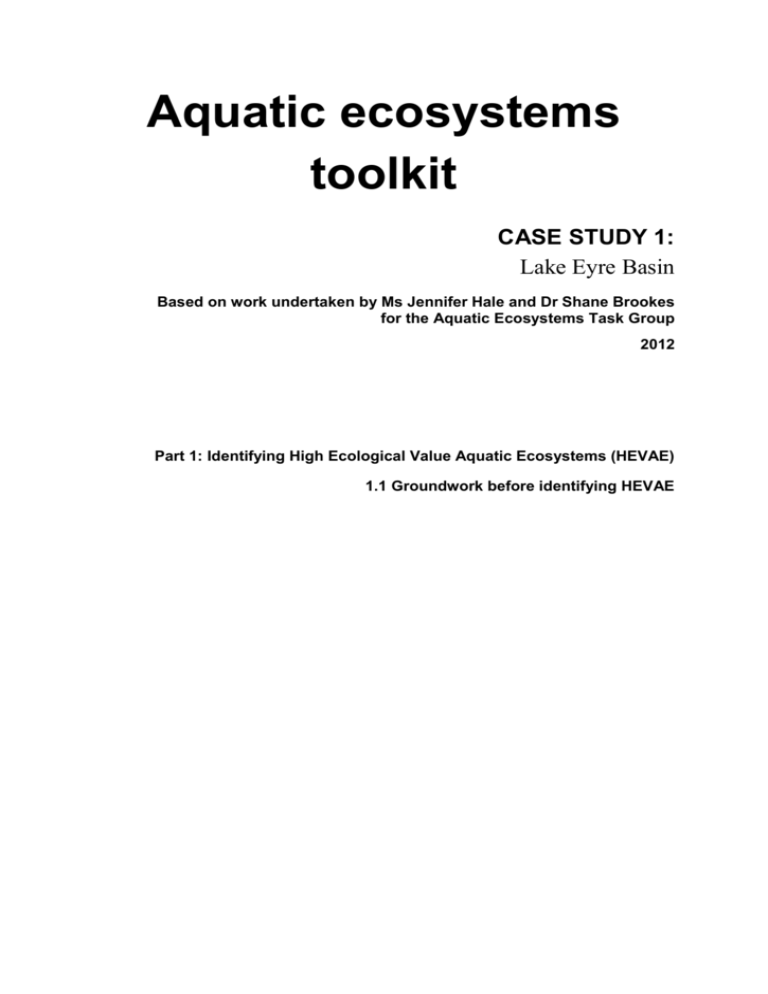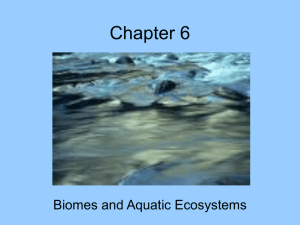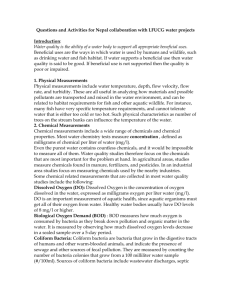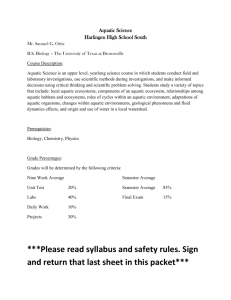
Aquatic ecosystems
toolkit
CASE STUDY 1:
Lake Eyre Basin
Based on work undertaken by Ms Jennifer Hale and Dr Shane Brookes
for the Aquatic Ecosystems Task Group
2012
Part 1: Identifying High Ecological Value Aquatic Ecosystems (HEVAE)
1.1 Groundwork before identifying HEVAE
Published by
Department of Sustainability, Environment, Water, Population and Communities
Authors/endorsement
This case study is based on trials of the draft Guidelines for Identifying High Ecological Value Aquatic
Ecosystems, and the draft Aquatic Ecosystem Delineation and Description Guidelines. The final reports from
these trials are as follows:
Hale, J. (ed.) (2010). Lake Eyre Basin High Conservation Aquatic Ecosystem Pilot Project. Report
prepared for the Aquatic Ecosystems Task Group and the Department of Environment, Water,
Heritage and the Arts. Jennifer Hale, Kinglake.
Hale, J., and Brooks, S. (2011). Trialling the guidelines for the delineation of High Ecological Value Aquatic
Ecosystems (HEVAE) in the Lake Eyre Basin (LEB). Report prepared for the Aquatic Ecosystems Task Group
and the Department of Sustainability, Environment, Water, Population and Communities. Jennifer Hale, Kinglake.
These reports are available on request from the Australian Government Department of Sustainability,
Environment, Water, Population and Communities.
Endorsed by the Standing Council on Environment and Water, 2012.
© Copyright Commonwealth of Australia 2012
This work is copyright. You may download, display, print and reproduce this material in unaltered form only
(retaining this notice) for your personal, non-commercial use or use within your organisation. Apart from any use
as permitted under the Copyright Act 1968 (Cwlth), all other rights are reserved. Requests and enquiries
concerning reproduction and rights should be addressed to Department of Sustainability, Environment, Water,
Population and Communities, Public Affairs, GPO Box 787 Canberra ACT 2601 or email
<public.affairs@environment.gov.au>.
Disclaimer
The views and opinions expressed in this publication are those of the authors and do not necessarily reflect those
of the Australian Government or the Minister for Sustainability, Environment, Water, Population and Communities,
nor the participating jurisdictional governments or ministers (Queensland, NSW, South Australia and Northern
Territory).
While reasonable efforts have been made to ensure that the contents of this publication are factually correct, the
Commonwealth does not accept responsibility for the accuracy or completeness of the contents, and shall not be
liable for any loss or damage that may be occasioned directly or indirectly through the use of, or reliance on, the
contents of this publication.
These trials were undertaken during the time when guidance on the identification, delineation and description of
aquatic ecosystems was an area of active policy development. The work informing the contents of this publication
was carried out under budgetary and time restraints, resulting in limited ability to incorporate all available
datasets and information into the process.
Citation
Aquatic Ecosystems Task Group (2012). Aquatic Ecosystems Toolkit. Case Study 1: Lake Eyre Basin.
Department of Sustainability, Environment, Water Population and Communities, Canberra.
For citation purposes, the PDF version of this document is considered the official version. The PDF is available
from:
<www.environment.gov.au/water/publications/environmental/ecosystems/ae-toolkit-cs-1.html>
ii
Part 1:
Identifying High Ecological Value Aquatic
Ecosystems (HEVAE)
1.1
Groundwork before identifying HEVAE
Whilst the Lake Eyre Basin (LEB) covers 15 percent of Australia, it is remote and poorly studied
compared with similarly sized drainage divisions. The LEB spans four state/territory boundaries
(Figure 1), and information collected prior to this project was not consistent or comprehensive across
the whole basin. Before applying Module 3 Guidelines for Identifying High Ecological Value Aquatic
Ecosystems (HEVAE), preliminary work was required to integrate existing data sets, to provide a
basin-wide information base.
Step 1 Identify purpose
The purpose of the assessment was to test the draft HEVAE Framework, and draft delineation
guidelines, (which have now been developed into Module 3: Guidelines for Identifying HEVAE, and
Module 4: Aquatic Ecosystem Delineation and Description Guidelines, respectively) in the Lake Eyre
Basin.
Step 2 Map and classify aquatic ecosystems
A consistent and comparable classification of aquatic ecosystems was required to apply a number of
the HEVAE criteria (particularly ‘diversity’ and ‘representativeness’). Two typologies were developed,
one for riverine and one for non-riverine aquatic ecosystems. This trial pre-dated the Australian
National Aquatic Ecosystem (ANAE) Classification Scheme, however the principles of the ANAE
Classification Scheme were used to identify aquatic ecosystem types.
Non-riverine (lacustrine/palustrine) aquatic ecosystems were defined as those that are not connected
to a mapped drainage channel, or are substantially wider than the channel (e.g. a lake fed by a river).
Riverine ecosystems were defined as all aquatic ecosystems and deepwater habitats within a channel
that are naturally or artificially created, periodically/continuously contain moving water, or form a
connecting link between two bodies of standing water.
A set of key classification attributes, that each jurisdiction could apply, were identified for both
non-riverine and riverine systems (Table 1).
The application of the classification system was based predominantly on existing data sources.
However, in order to minimise the number of systems that were classified as ‘unknown’ due to a lack
of information on one or more attribute, defaults based on stated assumptions were used. Defaults
were, in the absence of evidence or knowledge to the contrary:
fresh
non-permanent
riverine systems were considered channels
groundwater source was considered unconfined.
The final output was mapping of non-riverine aquatic ecosystems into 27 possible categories, and
riverine ecosystems into 32 categories, based on combinations of attributes (e.g. lowland/
floodplain/surface water/non-permanent/fresh).
2
Figure 1
Map of the Lake Eyre Basin drainage division showing major river systems and
jurisdictional boundaries
3
Table 1
Key attributes used to classify non-riverine and riverine aquatic ecosystems
across the Lake Eyre Basin
Landform:
Upland
Lowland
Based on a measure of roughness applied across the basin
using the 9 second Digital Elevation Model.
Non-riverine
& riverine
Dominant water
source:
Groundwater
Surface water
The ‘groundwater’ attribute is applied to those aquatic
ecosystems that have been identified in mapping or expert
panel review as being fed predominately by groundwater
(e.g. springs). The ‘surface water’ attribute covers all
wetland systems that have not been identified as having
characteristics that would indicate they are predominately
groundwater fed.
Non-riverine
& riverine
A sub-category of artesian versus unconfined aquifer
sources was applied to separate deep-water aquifer-fed
systems from surficial groundwater systems.
Connectivity:
Floodplain
Non-floodplain
Floodplains are defined in this trial* as (The National
Committee on Soil and Terrain, 20091):
Non-riverine
‘alluvial plains characterised by frequently active erosion
and aggradation by channelled or overbank stream flow.
Unless otherwise specified “frequently active” is to mean
that flow has an Average Recurrence Interval of 50 years or
less.’
The non-floodplain category covers the remaining systems
that may receive some flow from local watershed creeks but
are only very rarely or very minimally influenced by true river
systems. The ‘non-floodplain’ (spring) category includes all
mapped springs.
Connectivity:
Channel
Waterhole
Spring
Channel—water mostly flowing if present but may persist for Riverine
a few days as shallow water after flow stops.
Waterhole—water remains after flow stops for periods of
weeks through to permanent.
Spring—aquifer discharge feature on bank or bed of
watercourse or very close on adjacent cliff; discharge may
be intermittent and may rarely produce surface flows (i.e. a
seepage spring).
1
The National Committee on Soil and Terrain (2009). Australian Soil and Land Survey Field Handbook, Third
Edition, CSIRO Land and Water, Canberra.
4
Water regime:
Near-permanent
Non-permanent
Near-permanent—defined as those waterbodies that hold
water for >70% of the time.
Water type:
Fresh
Saline
Adoption of the Queensland wetland mapping definition
Non-riverine
where fresh is <3 ppt and saline >3 ppt. In the context of the & riverine
LEB, the attribute is applied based on the average
conditions within the wetland (i.e. the wetland may become
more saline as it dries, but is considered fresh if for the
majority of the time it holds water, salinity is <3 ppt).
However, few aquatic ecosystems contained salinity data. In
these cases salinity was identified through expert opinion or
defaulted to fresh.
Non-riverine
& riverine
Non-permanent—defined as those waterbodies that hold
water for <70% of the time.
* Note this definition differs somewhat from the one used in the ANAE Classification Scheme (Module 2), which defines floodplains as ‘areas that
are intermittently inundated by the lateral overflow of riverine, lacustrine or palustrine systems, by direct precipitation, or by groundwater’.
Step 3 Determine scale, regionalisation, and spatial units
The scale, regionalisation and spatial units relevant to the LEB HEVAE trial are illustrated in Figure 2.
Figure 2
Spatial scales used in the LEB HEVAE trial
5
a. Determine scale and regionalisation
The LEB drainage division boundary was defined by the Australian Water Resources Council (AWRC)
in the 1960s, and this boundary has been formally recognised in the LEB Agreement process.
However, in 2005, Duguid et al. documented the need for a major boundary change associated with
the catchment of the Karinga Creek and flow along the creek into the Finke River. Subsequently,
Geoscience Australia has re-mapped major river basin and drainage division boundaries across
Australia using a digital terrain model. This is part of a new Australian Hydrological Geospatial Fabric
(Geofabric). A near-final draft of the revised drainage division boundaries was obtained for use in the
LEB HEVAE trial. Queensland, South Australia and NSW chose to use the old boundary because of
its official status under the LEB Agreement, and because they had data already organised according
to that boundary, while the Northern Territory chose to use the new boundary.
Selection of an appropriate regionalisation for use at broader scales proved problematic, and three
options were considered: river catchments, Interim Bioregionalisation of Australia (IBRA), and a
regionalisation based on landscape form and function (a modified form of IBRA that accounted for the
major hydro-geomorphic types and landscape processes occurring in the LEB).
The project’s Technical Working Group (TWG) and Expert Reference Panel (ERP) (see Expert
knowledge input (below) decided that more than one regionalisation scheme could be selected for
application to different aspects of the HEVAE criteria. Two existing regionalisations (Figures 3a and b)
were selected that had broad applicability to aquatic ecosystem attributes:
Aquatic based regionalisation—Australian Surface Water Management Areas (SWMA) (with a
further split in South Australia to Lake Frome and Western Rivers). SWMA provide a broad
stratification on aquatic ecosystem characteristics and account for both longitudinal and
lateral connectivity. They were used specifically for identification of endemic species at the
sub-basin scale as well as for referencing diversity of aquatic ecosystems and species
richness of fish.
Geomorphic and climate-based regionalisation—Interim Bioregionalisation of Australia (IBRA)
was selected for referencing attributes that are known to vary with climate and
geomorphology across the basin (e.g. plant and amphibian species richness).
Figure 3a
Surface Water Management Areas (SWMA) in the Lake Eyre Basin
6
Figure 3b
Interim Bioregionalisation of Australia (IBRA) regions within the Lake Eyre Basin
b. Select spatial units
A top-down catchment-based approach was used to identify HEVAE, by assigning data to
assessment units rather than individual wetlands, waterholes or river reaches. This approach partially
overcame the problem of sample bias and uneven distribution of data between aquatic ecosystems in
the LEB. While the systematic description or delineation of important aquatic ecosystems within the
assessment units was not possible, assessment units that had a high probability of containing one or
more HEVAE could be identified. In some instances an assessment unit could also meet the HEVAE
criteria because of the presence of more than one disconnected aquatic ecosystem.
Two available datasets with delineations of catchments were investigated both based on digital
elevation models (DEM):
the recently developed National Catchment Boundaries (NCB) nested catchments that are
being beta tested by the Bureau of Meteorology for the Geofabric (based on the Pfafstetter
technique)
the 500-square-kilometre nested catchments data set provided by the Australian Government
Department of Sustainability, Environment, Water, Population and Communities (DSEWPaC).
The NCB nested catchments were rejected as the variability in area of ‘catchments’ within any given
level was considered too great for the LEB HEVAE trial, and there were instances where boundaries
did not align with on-ground knowledge of the TWG members. As a consequence, the 500-squarekilometre nested catchments data set provided by DSEWPaC was selected as an appropriate scale
for the assessment units. This resulted in approximately 1100 units across the LEB.
Each jurisdiction further customised these catchments as necessary to balance objective boundaries
derived from a DEM and ecologically meaningful units of an appropriate size. The process resulted in
1035 assessment units across the LEB ranging in size from 82 to 29 000 square kilometres, with a
median size of approximately 1000 square kilometres (Figure 4).
To apply the attributes for criteria (see Step 4b), each assessment unit needed to be ascribed to a
SWMA and IBRA region. Overlaying of the boundaries of assessment units with each of the
7
regionalisations indicated that a large number of assessment units spanned a regional boundary. To
address this, a ‘50 percent’ rule was applied whereby the assessment units were ascribed to the region
in which more than 50 percent of its area lay.
The intersection of the drainage division with the IBRA regions resulted in an imperfect fit, and a
number of IBRA regions were dissected by the drainage division boundary. There were several small
areas of IBRA regions that lay predominantly outside the LEB, which contained too few assessment
units (less than three) for meaningful, referential evaluations to be made. As a consequence,
assessment units in these small, partial IBRA regions were subsumed into adjoining IBRA regions for
the purpose of referential evaluations.
Figure 4
Assessment units in the LEB using the 500-square-kilometre nested catchments
data set
Expert knowledge input
The Technical Working Group (TWG) comprising representatives from the NSW, Northern Territory,
South Australia, Queensland and Australian governments was established to conduct the HEVAE
trials. The TWG worked in collaboration with scientific experts from government and research
organisations (the Expert Reference Panel).
The Expert Reference Panel (ERP) was assembled for both the HEVAE identification and delineation
trials. The ERP comprised of scientists with expertise in a range of relevant fields (including hydrology,
geomorphology, fish, waterbirds, vegetation, macroinvertebrates) and local knowledge and
experience in the LEB. The ERP met with the TWG twice during the HEVAE identification trial and
once during the delineation trial, and also contributed expert knowledge out of session.
The ERP’s role in the identification of potential HEVAE was to:
provide advice on decisions made regarding the method
augment the application of attributes and criteria for the identification of HEVAE, and provide
advice on the data and knowledge to delineate HEVAE by the input of expert opinion.
8









